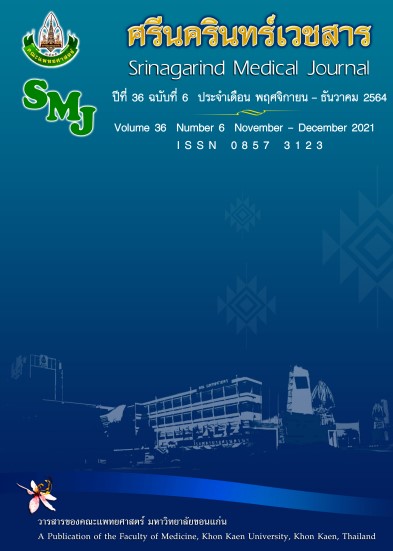Relationships between Teaching Quality, Continuity of Care, and Perceived Readiness for Hospital Discharge in Patients with Hip Replacement
Keywords:
Keyword: Readiness for hospital discharge; Teaching quality; Continuity of care; Patients with hip replacementAbstract
หลักการและวัตถุประสงค์ของการวิจัย: การจำหน่ายผู้ป่วยจากโรงพยาบาลอย่างมีประสิทธิภาพส่งผลให้ลดโอกาสกลับเข้ารับการรักษาซ้ำ การศึกษาความสัมพันธ์ระหว่างคุณภาพการสอนก่อนจำหน่าย การประสานการดูแลอย่างต่อเนื่อง กับการรับรู้ถึงความพร้อมก่อนจำหน่ายจากโรงพยาบาลในผู้ป่วยที่ได้รับการผ่าตัดเปลี่ยนข้อสะโพกเทียม พยาบาลทราบแนวทางในการวางแผนการจำหน่ายได้อย่างเหมาะสม
วิธีการศึกษา: การวิจัยแบบพรรณนาเชิงหาความสัมพันธ์กลุ่มตัวอย่างคือผู้ป่วยที่ได้รับการผ่าตัดเปลี่ยนข้อสะโพกเทียมที่เข้ารับการรักษาในโรงพยาบาลตติยภูมิแห่งหนึ่งในภาคเหนือของประเทศไทย ตามคุณสมบัติที่กำหนดไว้ จำนวน 97 ราย รวบรวมข้อมูลด้วยแบบสอบถามคุณภาพการสอนก่อนจำหน่าย การประสานการดูแลอย่างต่อเนื่อง และการรับรู้ถึงความพร้อมก่อนจำหน่าย ตั้งแต่เดือน ตุลาคม 2562 ถึงเดือน กรกฎาคม 2563 วิเคราะห์ข้อมูลด้วยสถิติสัมประสิทธิ์สหสัมพันธ์แบบเพียร์สัน
ผลการศึกษา: พบว่าคุณภาพการสอนก่อนจำหน่ายอยู่ในระดับดี (x̄ =191.05, SD=18.28) การประสานการดูแลอย่างต่อเนื่องอยู่ในระดับสูง (x̄ =107.17, SD=9.98) และการรับรู้ถึงความพร้อมก่อนจำหน่ายอยู่ในระดับสูง (x̄ =166.82, SD=16.40) ความสัมพันธ์ระหว่างคุณภาพการสอนก่อนจำหน่าย การประสานการดูแลอย่างต่อเนื่อง พบว่ามีความสัมพันธ์กับการรับรู้ถึงความพร้อมก่อนจำหน่ายจากโรงพยาบาล (r = .705, p<.01; และ r = .218, p<.01) ตามลำดับ
สรุป: ผลการศึกษานี้ เป็นข้อมูลพื้นฐานสำหรับเตรียมความพร้อมในการจำหน่ายจากโรงพยาบาลในผู้ป่วยได้รับการผ่าตัดเปลี่ยนข้อสะโพกเทียม ตลอดจนส่งเสริมการดูแลผู้ป่วยอย่างต่อเนื่องภายหลังจากการจำหน่าย
คำสำคัญ: ความพร้อมก่อนจำหน่ายจากโรงพยาบาล; คุณภาพการสอน; การประสานการดูแลอย่างต่อเนื่อง; ผู้ป่วยที่ได้รับการผ่าตัดเปลี่ยนข้อสะโพกเทียม
Background and Objective: Better readiness for hospital discharge should reduce likelihood of hip replacement patients later re-admission. This research studied the relationships between teaching quality, continuity of care, and perceived hospital discharge readiness in hip replacement patients to assist with more appropriate guidelines for discharge planning.
Methodology: This was a descriptive cross-sectional survey study. Ninety-seven hip arthroplasty patients treated at a tertiary hospital in Northern Thailand participated. Data were collected from October 2019 to July 2020 using a teaching quality questionnaire, a continuity of care questionnaire and a perceived hospital discharge readiness questionnaire. Data were analyzed using Pearson’s Product Moment Correlation Coefficient.
Results: The results showed that teaching quality was at good level (x̄ =166.82, SD=16.40), continuity of care at high level (x̄ =191.05, SD=18.28), and perceived readiness for hospital discharge was at high level (x̄ =107.17, SD=9.98). The relationships between teaching quality and continuity of care were positively and significantly related to perceived readiness for hospital discharge. (r = .705, p< 0.01; r = .218, p<.01, respectively).
Conclusion: The results of this study should provide essential information to prepare the patients for hip replacement, as well as contributing to continuing patient care after discharge.
Keyword: Readiness for hospital discharge; Teaching quality; Continuity of care; Patients with hip replacement




